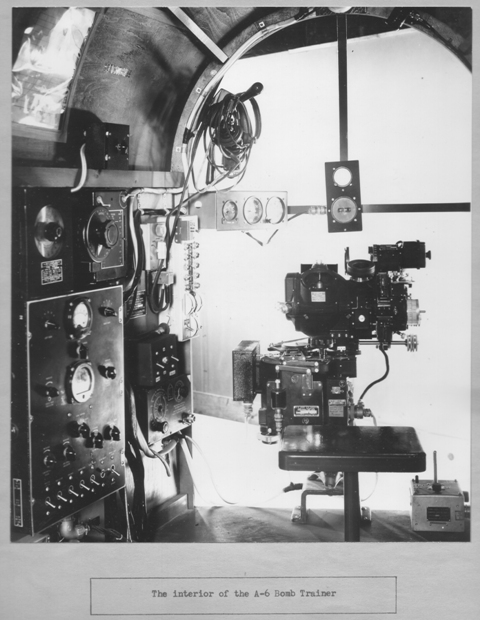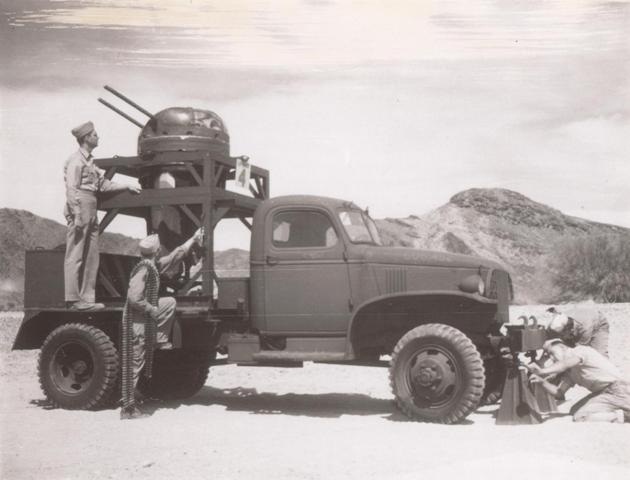Link Trainer and Other World War II Simulator Information
Mon Mar 15, 2021 8:23 pm
Following the thread about the Norden bombsight, I thought I would put together another one about the Link trainer - as well as any other similar World War II-era simulators.
Applicable Manuals
(Sources: Center for Technology & Innovation, AN 28-5A-2, eBay, AN 08-25-37)
Patents (Edwin Link or Link Aviation, Inc.)
Patents (Dehmel)
Patents (Bell Telephone Laboratories)
Patents (Other)
Other Aviation Trainers
Interestingly, there was apparently a lawsuit between Curtiss-Wright and Link over patent rights to the simulation technology.[2] This involved Richard C. Dehmel, who was the designer of the P-3 (developed from the Z-1 mentioned above), as well as a Boeing 377 simulator.[3][4]
Information on later devices can be found on the Aircrew Training Devices portion of the Wildfire Productions website.
EDIT (21-05-07): Added AN 08-25-37 to list of applicable manuals.
EDIT (23-08-14): Added 2,387,153 to list of other patents.
EDIT (24-04-18): Added 4 entries with links and 2 links to existing entries in list of applicable manuals.
Applicable Manuals
- Handbook of Instructions for Instrument Flying Trainer AN-2550-1 (AN-T-18)
- Illustrated Parts Catalog for Link Instrument Flying Trainers
- Link Instrument and Radio Trainer Type AN-T-18 Handbook of Instructions
- Link Instrument and Radio Trainer Type C-3 Handbook
- 90097 - Instructions Standard Field Overhaul (C-3 Trainer Models)
- AN 08-25-15 - Handbook of Instructions - Instrument Flying Trainer, AN-2550-1 (Link)
- AN 08-25-16 - Parts Catalog - Instrument Flying Trainer, AN-2550-1 (Link)
- AN 08-25-32 - Handbook of Instructions with Parts Catalog - A-1 Interphone Radio Assembly
- AN 08-25A-1 - Handbook of Link Trainer Instruments with Parts Catalog (Kollsman)
- AN 08-25A-7 - Handbook of Instructions with Parts Catalog - Turn and Bank Indicators, Type 1705-2T-A2, 1705-2AA-A2, and 1705-2AA-B2 (Pioneer)
- AN 08-25-37 - Handbook of Instructions with Parts Catalog - Instrument Trainer Recorder Tester, Type IRT-300
- AN 28-5-1 - Miniature Radio Range Trainer Type M-1
- AN 28-5-4 - Handbook of Instructions with Parts Catalog - Artificial Horizon Indicator (Link)
- AN 28-5-5 - Handbook of Instructions with Parts Catalog - Standard Beam Approach Indicator (Flight Path) Type No. 1 (Path)
- AN 28-5-16 - Handbook of Instructions with Parts Catalog - Model 635, Types 11, 56P, and 57P Cross Pointer Indicators (Weston)
- AN 28-5-19 - Handbook of Instructions with Parts Catalog - Autosyn Instrument, Type 2300-2-A (Pioneer)
- AN 28-5-21 - Handbook of Instructions with Parts Catalog for Indicators Model 602
- AN 28-5A-1 - Handbook of Instructions with Parts Catalog for the Simulated Directional Gyro (Link)
- AN 28-5A-2 - Overhaul Instructions for Instrument Flying Trainer Type, AN-2550-1
- AN 28-5A-14 - Handbook of Operation, Service, and Overhaul Instructions with Parts Catalog - Turn and Bank Indicator
- AN 28-5A-19 - Handbook of Operation and Service Instructions - Basic Instrument Trainer 45
- AN 28-5A-20 - Parts Catalog - Basic Instrument Trainer 45
- AN 28-5A-27A - Parts Catalog Supplement - Contact and Instrument Flying Trainer
- AN 28-5-42 - Overhaul Instructions with Parts Breakdown - Single Manifold Pressure Autosyn Indicator
- AN 28-5B-1 - Handbook of Operation and Service Instructions - Celestial Navigation Trainer AN-2554-1
- AN 28-5B-2 - Handbook of Overhaul Instructions - Celestial Navigation Trainer AN-2554-1
- TM 1-445 - Instrument Flying Training [also titled "Link Trainer Operation and Training"]
- TM 1-447 - Instrument Trainer Maintenance
- T.O. No. 00-25-16 - Instrument Flying Trainer Operation Inspection and Maintenance Record
- T.O. No. 05-1-1 - Inspection, Maintenance, Storage, and Shipment of Instrument Maintenance Parts
- T.O. No. 05-1-9 - Handbook of Instructions with Parts Catalog - Aircraft Clocks (Jaeger)
- T.O. No. 05-1-13 - Handbook of Overhaul Instructions - Voltmeters, Ammeters, and Volt-Ammeters
- T.O. No. 05-15-2 - Handbook of Service and Overhaul Instructions for Magnetic Type Compasses
- T.O. No. 05-20-7 - Handbook of Instructions with Parts Catalog - Link Trainer Turn and Bank Indicator Type 1716-2N-A2 (Pioneer)
- T.O. No. 08-25-1 - Operation and Service Instructions - Instrument Flying Trainers Types as Enumerated
- T.O. No. 08-25-2 - Handbook of Overhaul Instructions - Instrument Flying Trainers Type C-2, -3, -4 and -5
- T.O. No. 08-25-8 - Interchangeable Parts Catalog - Instrument Flying Trainers Types C-2, 3, 4 & 5 D, D-1, D-2, E1, E-2 E-Special and AN-2550-1
- T.O. No. 28-5A-15 - Operation, Service and Overhaul Instructions with Illustrated Parts Breakdown - Kollsman Instruments used in Link Flight Trainers
- T.O. No. 28-5A-17 - Installation of Shielded Cable in Radio Chassis AN-2550-1 Instrument Flying Trainer
- T.O. No. 28-5-24 - Operation, Service and Overhaul Instructions with Parts Catalog for Indicator, Sensitive Altimeter
- T.O. No. 28-5A-24 - Inspection and Maintenance Guide for Instrument Flying Trainers Type C-3 and AN 2550-1
- T.O. No. 28-5A-25 - Operation and Service Instructions for Instrument Flying and Landing Trainer (Ground) Type C-8
- T.O. No. 28-5A-27 - Parts Catalog for Instrument Flying and Landing Trainer (Ground) Type C-8
(Sources: Center for Technology & Innovation, AN 28-5A-2, eBay, AN 08-25-37)
Patents (Edwin Link or Link Aviation, Inc.)
- 1,825,462 - Combination Training Device for Student Aviators and Entertainment Apparatus
- 2,099,857 - Trainer for Aviators
- 2,119,083 - Aviation Trainer
- 2,179,663 - Recorder
- 2,364,539 - Celestial Navigation Trainer
- 2,417,554 - Locking Device for Aviation Trainers
- 2,435,502 - Radio Signaling Means for Aviation Trainers
- 2,439,168 - Constant Speed Propeller Simulating Means for Aviation Trainers
- 2,442,297 - Training Device
- 2,443,076 - Simulated Directional Gyro for Aviation Trainers
- 2,445,673 - Magnetic Compass Indicating System for Aviation Trainers
- 2,450,239 - Aviation Trainer
- 2,450,240 - Radio Direction Finding Means for Aviation Trainers
- 2,450,261 - Training Equipment for Aviators
- 2,510,500 - Grounded Pilot Training Apparatus
- 2,510,529 - Diving and Climbing Target Simulator for Ground Trainers
- 2,510,578 - Aviation Trainer
- 2,510,579 - Weathercocking Simulating Means for Grounded Aviation Trainers
- 2,510,580 - Northerly Turning Error Compass Simulating Means for Grounded Aviation Trainers
- 2,514,762 - Main and Auxiliary Control Valve Arrangement for Grounded Aviation Trainers
Patents (Dehmel)
- 2,443,604 - Aircraft Training Apparatus
- 2,474,096 - Optical Training Apparatus
- 2,471,315 - Aircraft Trainer for Aerial Gunners
- 2,506,998 - Flight Navigation Training Apparatus
- 2,522,434 - Control Response Trainer for Aircraft Pilots
- 2,529,468 - Radio Range Navigation Apparatus for Training Aircraft Personnel
- 2,560,528 - Training Means for Blind Navigation Systems
- 2,510,385 - Flight Training Apparatus
- 2,687,580 - Flight Training Apparatus for Computing Flight Conditions and Simulating Reaction of Forces on Pilot
Patents (Bell Telephone Laboratories)
- 2,379,869 - Directional Compass for Aircraft Trainers
- 2,499,597 - Engine Manifold Pressure Simulating Apparatus for Aircraft Ground Trainers
- 2,533,484 - Trainer for Aircraft Personnel
- 2,554,155 - Ground Trainer for Training Aircraft Crews
- 2,564,429 - Ground Trainer for Aircraft Personnel
Patents (Other)
- 2,313,480 - Apparatus for Training Pilots, Navigators, and Like Aircraft Personnel
- 2,357,304 - Antispin Attachment for Link Trainers
- 2,373,313 - Synthetic Flying Trainer
- 2,362,486 - Air Speed Control and Spin Delay Assembly for Link Trainers
- 2,383,006 - Testing Apparatus for Link Trainer Recorders
- 2,387,153 - Apparatus for Training Gunners
- 2,428,432 - Aerial Trainer
- 2,448,555 - Automatic Radio Range Control for Flight Trainers
- 2,510,161 - Simulated Air-speed Indicating Means for Aviation Ground Trainers
Other Aviation Trainers
- 7A-3 Trainer
- A-2 Bomb Trainer

(Source: Semantic Scholar) - Curtiss-Wright Z-1

(Source: The National Center for Simulation) - Link A-6 Bombing Trainer
(Source: TwinBeech.com) - Link Celestial Navigation Trainer
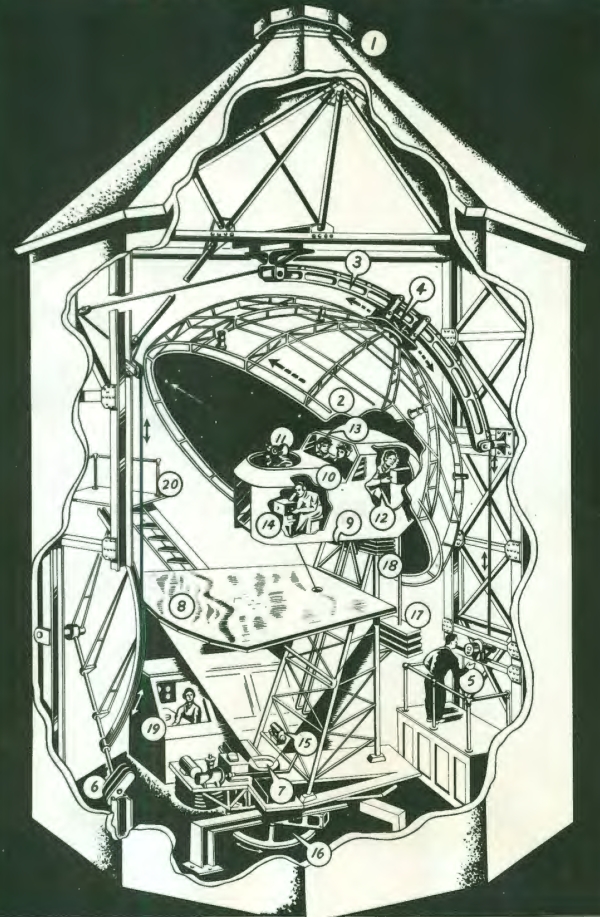
(Source: Bookworm History) - Edmondes Gunnery Trainer

(Source: Synthetic Training Devices of WW2 - Flight simulators) - Gunairstructor

(Source: Synthetic Training Devices of WW2 - Flight simulators) - Hawarden Spitfire Trainer[1]
- Torpedo Attack Simulator

(Source: Synthetic Training Devices of WW2 - Flight simulators) - Torpedo Bomber Training Simulator

(Source: Synthetic Training Devices of WW2 - Flight simulators) - Silloth Trainer

(Source: Synthetic Training Devices of WW2 - Flight simulators)
Interestingly, there was apparently a lawsuit between Curtiss-Wright and Link over patent rights to the simulation technology.[2] This involved Richard C. Dehmel, who was the designer of the P-3 (developed from the Z-1 mentioned above), as well as a Boeing 377 simulator.[3][4]
Information on later devices can be found on the Aircrew Training Devices portion of the Wildfire Productions website.
EDIT (21-05-07): Added AN 08-25-37 to list of applicable manuals.
EDIT (23-08-14): Added 2,387,153 to list of other patents.
EDIT (24-04-18): Added 4 entries with links and 2 links to existing entries in list of applicable manuals.
Last edited by Noha307 on Thu Apr 18, 2024 4:43 pm, edited 3 times in total.
Re: Link Trainer and Other World War II Simulator Informatio
Tue Mar 16, 2021 8:34 am
That is awesome - thank you! I would love to fond someone with the skills AND desire to take a whack at building a Norden A-2 trainer! The base Fire Station at Wendover Airifeld was originally a A-2 trainer building. After the war they added doors and converted it into its present use. When the use demand of the field required us to upgrade to a modern building for the Class B crash truck we were able to start restoring soem parts of the old building. A A-2 trainer would be a cool addition!
Wendover also had 4 celestial navigation trainers - but recreating those is another story. . .
Tom P.
Wendover also had 4 celestial navigation trainers - but recreating those is another story. . .
Tom P.
Re: Link Trainer and Other World War II Simulator Informatio
Thu Apr 15, 2021 5:39 pm
Other Aviation Trainers (Cont.)
I should note that in addition to Taigh Ramey's E-5, someone from an organization called Depot 41 is also restoring one.
- Mobile Instructional Unit

(Source: Air Force Museum of New Zealand) - Nash & Thomson FN16 Turret Trainer
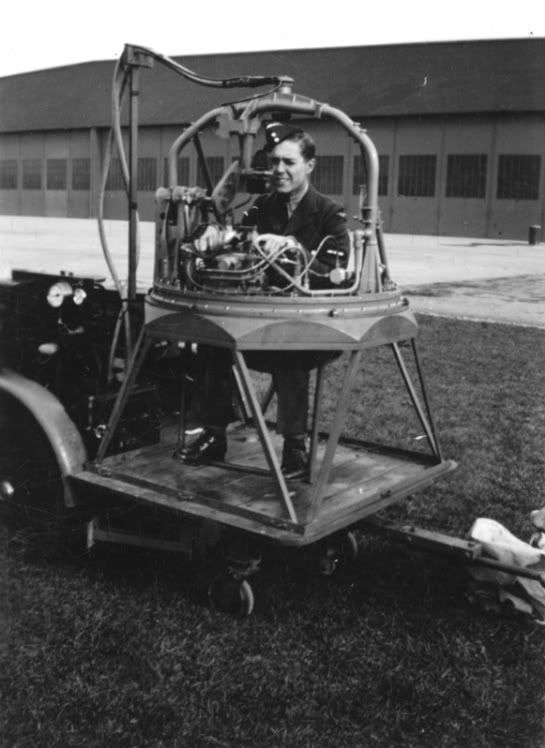
(Source: Warbird Information Exchange) - BP Type A Turret Trainer

(Source: Flickr) - Turret Stand Truck Device 3-C-12

(Source: Flickr) - Chevy E-5 (Upper Turret)
(Source: TwinBeech.com) - Chevy E-5 (Ball Turret)
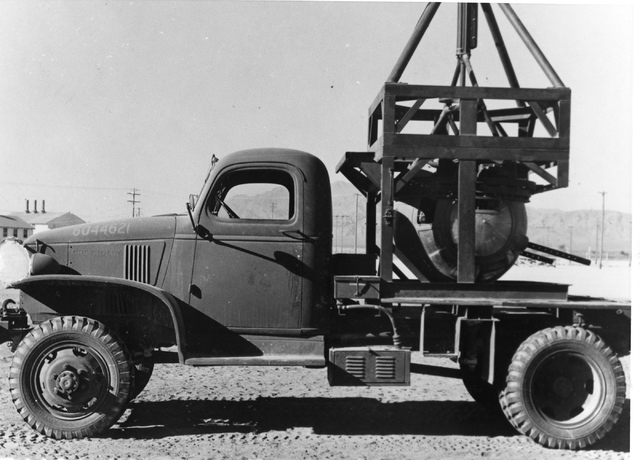
(Source: Historic Utah) - Ball Turret Manipulation Trainer

(Source: OnCell)
I should note that in addition to Taigh Ramey's E-5, someone from an organization called Depot 41 is also restoring one.
Re: Link Trainer and Other World War II Simulator Informatio
Sun May 09, 2021 9:20 pm
I was watching an old film titled A History of U.S. Naval Aviation today and it had two trainers/simulators in it. Some quick screengrabs from the video. I'm not sure what the first one is, but it involves actual shooting:
(Source: Internet Archive)
However, I think the second one may be a Link C-8:
(Source: Internet Archive)
(Source: Internet Archive)
However, I think the second one may be a Link C-8:
(Source: Internet Archive)
Re: Link Trainer and Other World War II Simulator Informatio
Thu Jun 17, 2021 3:29 pm
I came across a two more pictures of simulator style equipment. The first claims to show a "Sperry Bombsight School" and depicts what appear to be mockups of a B-24 and B-34 nose. However, scene looks more like a research setting than a training one. (How many trainees wear lab coats?) In any event, the mockups are somewhat reminiscent of the A-6 trainer mentioned above:
(Source: Aviation Week via Internet Archive)
The other is a picture of "[a] variant of the Sperry bombsight undergoing evaluation by the Engineering Division in 1936". The man operating the sight appears to be sitting in a device similar to the A-2 trainer mentioned above:
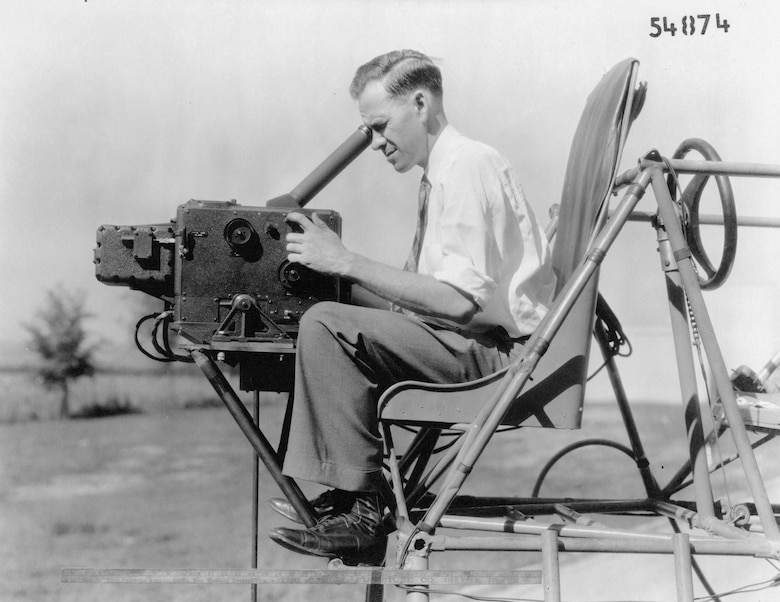
(Source: National Museum of the United States Air Force)
(Source: Aviation Week via Internet Archive)
The other is a picture of "[a] variant of the Sperry bombsight undergoing evaluation by the Engineering Division in 1936". The man operating the sight appears to be sitting in a device similar to the A-2 trainer mentioned above:

(Source: National Museum of the United States Air Force)
Re: Link Trainer and Other World War II Simulator Informatio
Mon Jun 21, 2021 6:08 pm
While perusing an issue of Aerial Age Weekly from 1922, I came across a potential indirect progenitor to the Link trainer with a great name: the Ruggles Orientator. While clearly not doing everything the Link can do, it does use a reproduction airplane cockpit section and includes at least a partial range of motion. Also, like the Link trainer, the caption states that it "will be manufactured for...amusement park purposes":
(Source: Aerial Age Weekly via Internet Archive)
(Source: Aerial Age Weekly via Internet Archive)
Re: Link Trainer and Other World War II Simulator Informatio
Tue Jun 22, 2021 1:11 pm
These two images,from the Fuerza Aérea Guatemalteca - Guatemalan Air Force files.
one is the classic Link trainer, while the other is a simulator built on an AT-11 nose.
Saludos,
Tulio
one is the classic Link trainer, while the other is a simulator built on an AT-11 nose.
Saludos,
Tulio
- Attachments
-
- Scan-081019-0017.jpg (76.67 KiB) Viewed 14423 times
-
- Scan-081019-0025.jpg (56.07 KiB) Viewed 14423 times
Re: Link Trainer and Other World War II Simulator Informatio
Tue Jun 22, 2021 1:16 pm
From the end of the 1930s and through the WW-II years, the Argentinean Air Force operated a number of Martin 39 WAA/ WAN twin-engine bombers.
The photos are from a 1941 photo-essay by Gordon Hart (sp?) and LIFE Magazine.
The images show the bombing trainers.
Saludos,
Tulio
The photos are from a 1941 photo-essay by Gordon Hart (sp?) and LIFE Magazine.
The images show the bombing trainers.
Saludos,
Tulio
- Attachments
-
- Argentina 1941 Hart Preston 36.jpg (84.09 KiB) Viewed 14422 times
-
- Argentina 1941 Hart Preston 31.jpg (96.58 KiB) Viewed 14422 times
-
- Argentina 1941 Hart Preston 27.jpg (112.94 KiB) Viewed 14422 times
Re: Link Trainer and Other World War II Simulator Informatio
Tue Jun 22, 2021 1:23 pm
more
- Attachments
-
- Argentina 1941 Hart Preston 48.jpg (106.9 KiB) Viewed 14421 times
-
- Argentina 1941 Hart Preston 69.jpg (99.38 KiB) Viewed 14421 times
-
- Argentina 1941 Hart Preston 20001.jpg (80.76 KiB) Viewed 14421 times
Re: Link Trainer and Other World War II Simulator Informatio
Tue Jun 22, 2021 10:21 pm
Tulio wrote:From the end of the 1930s and through the WW-II years, the Argentinean Air Force operated a number of Martin 39 WAA/ WAN twin-engine bombers.
The photos are from a 1941 photo-essay by Gordon Hart (sp?) and LIFE Magazine.
The images show the bombing trainers.
Saludos,
Tulio
Great find, Tulio! This may be the same plane that is now in the NMUSAF - the history I've read on it refers to its use as a "mock-up trainer". The museum referred to it as a "Martin 139W".
Re: Link Trainer and Other World War II Simulator Informatio
Wed Jun 23, 2021 11:32 am
[/quote]
Great find, Tulio! This may be the same plane that is now in the NMUSAF - the history I've read on it refers to its use as a "mock-up trainer". The museum referred to it as a "Martin 139W".[/quote]
Chris,
The LIFE magazine photo archives, hold an invaluable collection of high quality images, amongst which, are color shots of aircraft. B&W images are also high quality:
https://www.life.com/life-picture-collection/
Saludos,
Tulio
Great find, Tulio! This may be the same plane that is now in the NMUSAF - the history I've read on it refers to its use as a "mock-up trainer". The museum referred to it as a "Martin 139W".[/quote]
Chris,
The LIFE magazine photo archives, hold an invaluable collection of high quality images, amongst which, are color shots of aircraft. B&W images are also high quality:
https://www.life.com/life-picture-collection/
Saludos,
Tulio
Re: Link Trainer and Other World War II Simulator Informatio
Sat Jun 26, 2021 9:54 pm
Tulio, that's some neat stuff! Thanks for sharing!
Speaking of neat stuff, it just so happens just yesterday I found out that a group in Italy called the Gruppo Amici Velivoli Storici ("Historical Aircraft Friends Group") has restored no less than five(!) different simulators from the World War I-era. A few pictures of them in use back in the day:
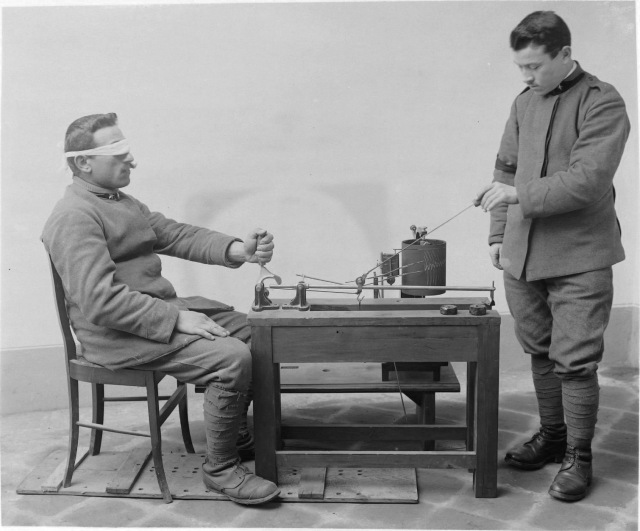
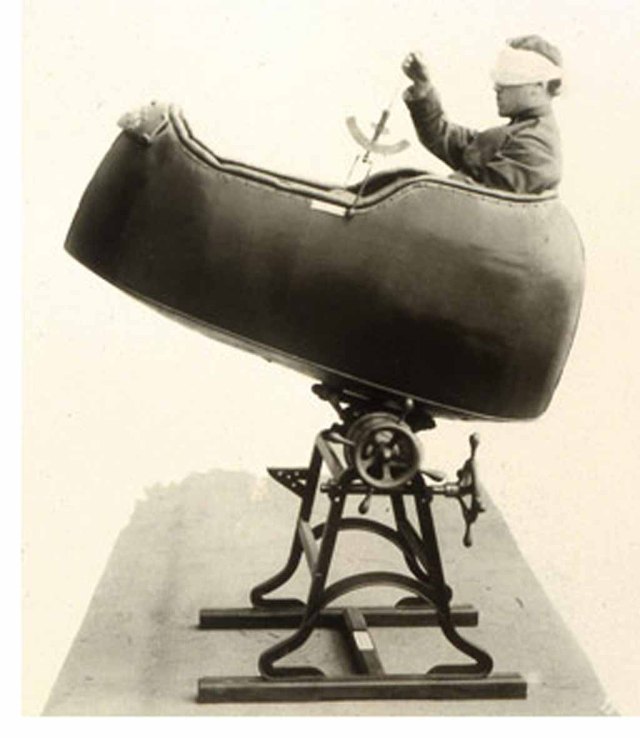
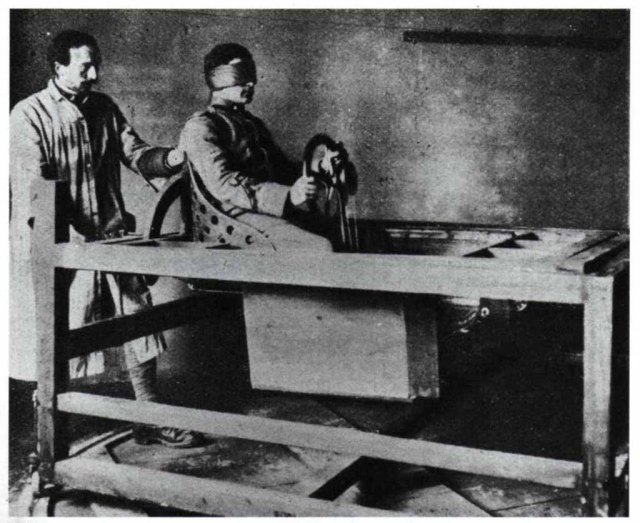
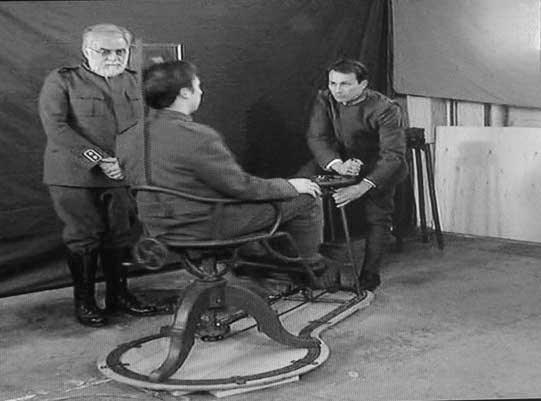
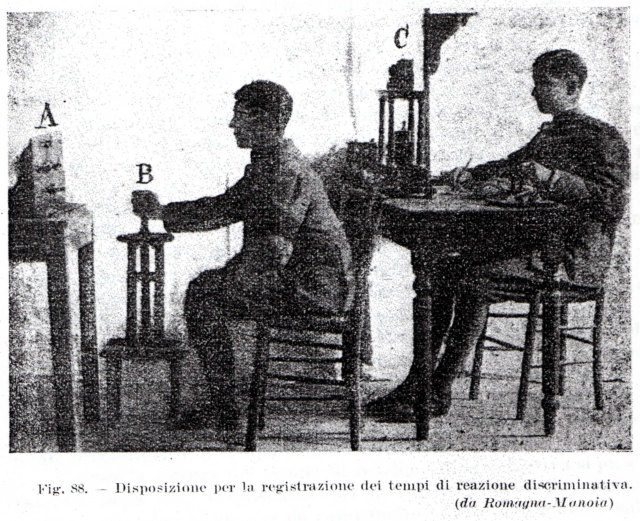
(Source: GAVS Turino)
Speaking of neat stuff, it just so happens just yesterday I found out that a group in Italy called the Gruppo Amici Velivoli Storici ("Historical Aircraft Friends Group") has restored no less than five(!) different simulators from the World War I-era. A few pictures of them in use back in the day:





(Source: GAVS Turino)
Re: Link Trainer and Other World War II Simulator Informatio
Sun Jun 27, 2021 4:46 pm
AirCorps Library just recently posted a few manuals related to the Link Trainer. Among them is a comb bound booklet titled Link Aviation Trainer for Instrument Flying, Landing, and Radio Navigation published by the J.V.W. Corporation and it just so happens to have exactly what I was looking for: a part by part differentiation between the types of wartime Link Trainer. According to it, the Type C-2, D, E, C-3, and C-5 all have the following cockpit equipment in common:
However, they differ in other installed equipment:
A footnote indicates that "flight path indicators can be supplied as extra equipment in Type C-3 and C-5 if desired.
Similarly, all five of the above types share the following instructor's desk equipment:
Again, they differ in other installed equipment:
Because the above is a confusing mess of text, here's two charts:
A couple of notes:
EDIT (21-07-04): I realized I misspelled a word in the desk equipment chart, it has been replaced with a fixed version.
EDIT (23-08-14): I came across a website the other day called PRC68.com that has a page with a section that includes a very similar in concept Link trainer variant comparison table to the above.
- Magnetic Compass
- Air Speed Indicator
- Turn and Bank
- Vertical Speed
- Directional Gyro
- Artificial Horizon
- Sensitive Altimeter
- Tachometer
- Switch On and Off
- Set of Headphones
- Microphone
- Throttle
- Radio Volume Control
However, they differ in other installed equipment:
- Type C-2: Code Key; Marker Beacon Indicator, Visual; Radio Compass and Sensitivity Control; Interchangeable Wheel-Stick Control
- Type D: Code Key; Clock; Landing Path Control; Combination Flight Path and Marker Beacon Indicator
- Type E: Code Key; Clock; Landing Path Control; Combination Flight Path and Marker Beacon Indicator; Radio Compass
- Type C-3: Marker Beacon Indicator, Visual; Radio Compass; Radio Compass Sensitivity Control; Clock; Fuel Gauge; Leveling Device; Interchangeable Wheel-Stick Control
- Type C-5: Fuselage Control Box (Light Dimmers, Radio Compass Sensitivity Control, Microphone and Headphone Jacks); Marker Beacon Indicator, Visual; Radio Compass; Fuel Gauge; Clock; Radio Receiver Turning Control, Retractable Loop; Leveling Device; Interchangeable Wheel-Stick Control
A footnote indicates that "flight path indicators can be supplied as extra equipment in Type C-3 and C-5 if desired.
Similarly, all five of the above types share the following instructor's desk equipment:
- Automatic Course Recorder
- Set of Headphones
- Microphone and Stand
Again, they differ in other installed equipment:
- Type C-2: Code Key; Complete Link Signal Generator and Controls with two way communication including A-N cams, switch for Voice and Code, and five station call signals
- Type D: Code Key; Complete Link Signal Generator and Controls with two way communication including E-T signal cams and switch for Voice and Code; Set of instruments on panel including Landing Path Indicator, Sensitive Altimeter, Air Speed Indicator, Vertical Speed Indicator; Visual and Aural Marker Beacon Controls; Landing Path Indicator Controls
- Type E: Code Key; Complete Link Signal Generator and Controls with two way communication including A-N and E-T signal cams and switch for Voice and Code, four station call signals; Set of instruments on panel including Landing Path Indicator, Sensitive Altimeter, Air Speed Indicator, Vertical Speed Indicator; Visual and Aural Marker Beacon Controls; Landing Path Indicator Controls
- Type C-3: Complete Link Signal Generator and Controls with two way communication including A-N cams, switch for Voice and Code, and five station call signals; Set of instruments including Sensitive Altimeter, Air Speed Indicator, Vertical Speed Indicator; Visual and Aural Marker Beacon Controls; Wind Direction and Wind Velocity Controls and Dials
- Type C-5: Complete Link Signal Generator and Controls Type C-5; Set of instruments including Sensitive Altimeter, Air Speed Indicator, Vertical Speed Indicator; Wind Direction and Wind Velocity Controls and Dials; Radio Compass Controls; Two Additional Headphones
Because the above is a confusing mess of text, here's two charts:
A couple of notes:
- I have yet to find information about the Type B.
- In a bit of designation confusion, what Link Aviation Devices (LAD) referred to as the C was called the C-2 by the USAAF. The LAD C-2 was only used commercially. Similarly, LAD's E Special was called the C-4 by the USAAF. The following chart was transcribed from the Illustrated Parts Catalog for Link Instrument Flying Trainers from the CT&I Techworks:
- The Type D had at least three additional variants: the D-1, D-2, and D-4. The D-2 and D-4 were built under license in Canada and England, respectively. I have yet to find a mention of a D-3. All versions of the Type D appear to have a sliding hood rather than a hinged one.
- The Type E also had at two additional variants: the E-1 and E-2. The base model (i.e. the one without a variant number) was a commercial version not used by the military.
- There is also a AN-2550-1 or AN-T-18. It was developed from the C-3 and added added landing gear, propeller pitch and flap controls.
- A recent revelation about the two Link trainers at our museum made me realize that the one version was made our of wood and another metal. I don't know anything about when or how the change was made. All I do know is the wood desk came with the AN-T-18 and the metal desk with the C-3.
EDIT (21-07-04): I realized I misspelled a word in the desk equipment chart, it has been replaced with a fixed version.
EDIT (23-08-14): I came across a website the other day called PRC68.com that has a page with a section that includes a very similar in concept Link trainer variant comparison table to the above.
Last edited by Noha307 on Mon Aug 14, 2023 6:41 pm, edited 3 times in total.
Re: Link Trainer and Other World War II Simulator Informatio
Tue Jun 29, 2021 4:18 pm
I think Il Duce used that same model of blindfold! 
Noha307 wrote:Speaking of neat stuff, it just so happens just yesterday I found out that a group in Italy called the Gruppo Amici Velivoli Storici ("Historical Aircraft Friends Group") has restored no less than five(!) different simulators from the World War I-era. A few pictures of them in use back in the day:
Re: Link Trainer and Other World War II Simulator Informatio
Wed Jun 30, 2021 10:48 pm
Saludos!!!
Tulio
Tulio
- Attachments
-
- PSX_20210630_194233.jpg (118.34 KiB) Viewed 13994 times
